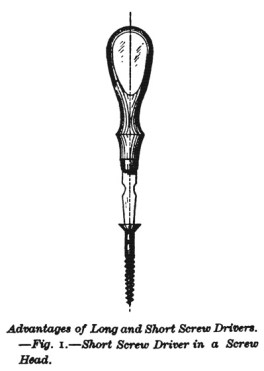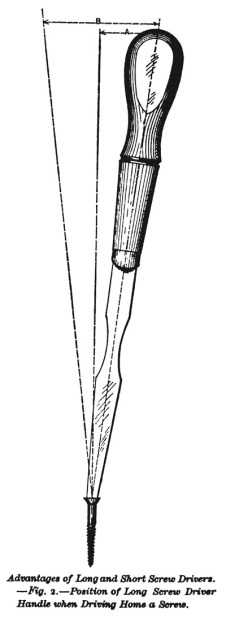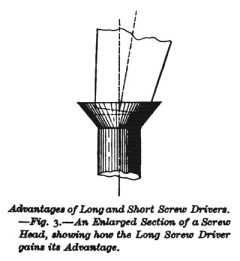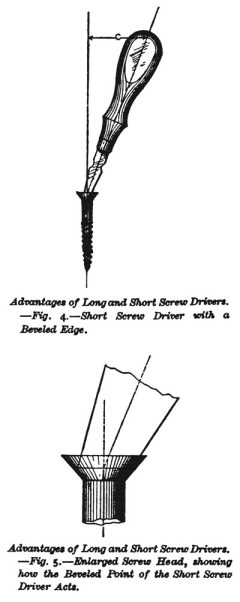The Relative Advantages of Long and Short Screw Drivers –

From L. R. H., North Argyle, N.Y. — Will you please inform me what philosophical principle is involved in the fact that a long screw-driver will turn a screw with less power than a short one? Can you explain the phenomenon to an unphilosophical subscriber?
Answer.—Our correspondent, in asking his question, virtually asserts that, with a long screw-driver, more power can be applied to the head of a screw than with a short one. This fact has often been denied, yet we believe it to be well established. The difference in the lengths of the screw-drivers admits of a difference in the manner of using them, and this difference in the way of using accounts for the difference in the power exerted.

In Fig. 1 of the accompanying illustrations we represent a short screw-driver at work. It will be noticed that the center line of the screw coincides with the center line of the screw-driver. If a long screwdriver were placed in exactly the same position, and were to be held, while being used, as straight as it is necessary to hold the short screw-driver, the results obtained would be substantially the same in the two.
The usual manner of using a long screwdriver, however, is like that shown in Fig. 2. Instead of the screw-driver being held exactly in line with the center of the screw, it is inclined to one side, which, in effect, makes the handle very much larger than it really is. The space A in Fig. 2 shows the inclination of the handle from a vertical line. The space B, which is double that of A, represents the diameter which the handle of the screw-driver in effect has by virtue of being worked in the manner indicated.
Fig. 3 shows an enlarged section of the screw head, showing the point of a long screw-driver in the slot, and illustrates the leverage obtained by the long screw-driver when inclined. A short screw-driver inclined so as to move in a circle having a diameter equal to B of Fig. 2, would be thrown out of the slot in the screw head.

Figs. 4 and 5 represent an experiment made to demonstrate the truth of the principles we have just described. The point of a small screw-driver is ground, beveling so as to give its handle, when revolving, motion in a circle of diameter equal to that of the long screw-driver. In other words, the space C in Fig. 4 is made to correspond with the space A in Fig. 2. With the short screw-driver thus managed, no more power is required to operate it than is required to operate the long screw-driver. Hence it would seem that the reason for a long handled screw driver  requiring less power than a short one lies in the facts we have described—partly in its having a larger handle, whereby power is more readily communicated, and partly because a larger handle, in effect, is given to the screw-driver by its handle being moved in a circle.
requiring less power than a short one lies in the facts we have described—partly in its having a larger handle, whereby power is more readily communicated, and partly because a larger handle, in effect, is given to the screw-driver by its handle being moved in a circle.
Carpentry and Building – August, 1880
– Jeff Burks





